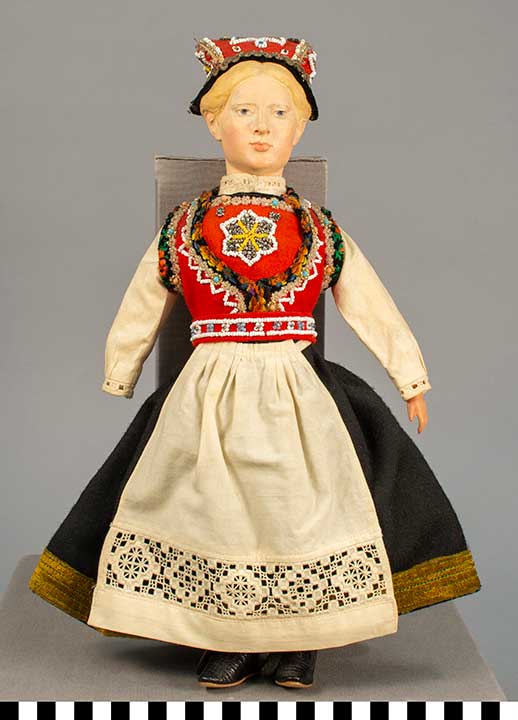Female Doll: Hardanger (Norway)
1913.07.0040A
Detailed Images
Basic Information
| Artifact Identification | Female Doll: Hardanger (Norway) (1913.07.0040A) |
|---|---|
| Classification/ Nomenclature |
|
| Artist/Maker | Unknown |
| Geographic Location | |
| Period | N/A |
| Date | Late-19th century – Early-20th century |
| Culture | Norwegian |
| Location | Not on Exhibit |
Physical Analysis
| Dimension 1 (Height) | 36.7 cm |
|---|---|
| Dimension 2 (Width) | 27.1 cm |
| Dimension 3 (Depth) | 7.3 cm |
| Weight | 390 g |
| Measuring Remarks | Under Review |
| Materials | Plaster, Plastic--Celluloid, Pigment--Paint, Glass, Animal--Skin--without Fur/Feathers/Scales, Metal, Textile--Brocade, Textile--Cotton, Textile--Knit, Textile--Lace--Machine-Made Lace, Textile--Linen, Textile--Metallic, Textile--Pile, Textile--Twill, Textile--Wool |
| Manufacturing Processes | Cast, Painted, Textile--Lace--Machine-Made Lace, Beaded, Textile--Hand Sewn, Textile--Machine Sewn, Textile--Appliqué, Textile--Knitted, Textile--Embroidered--Hardanger |
Research Remarks
| Description | N/A |
|---|---|
| Published Description | Under Review |
| Bibliography | Bridgewater, William, and Seymour Kurtz, eds. The Columbia Encyclopedia. 3rd ed. New York & London: Columbia University Press, 1963, p. 2382. |
Artifact History
| Credit Line/Dedication | Purchase |
|---|---|
| Reproduction | no |
Contact
All information about our collection is constantly reviewed and updated. Please contact Dery Martínez-Bonilla, Registrar, if there is any information you are looking for that isn't currently online.
